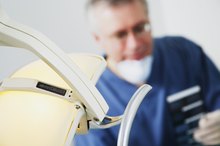How to Prevent a Gag Reflex With False Teeth
The gag reflex that you may encounter when you first wear false teeth is normal. Your gag reflex helps you to protect yourself from dangerous substances entering your body. The gag reflex is often activated when the roof of your mouth or the back of your tongue or throat area is touched, according to The Newcastle upon Tyne Hospitals Organization 1.
Your gag reflex is hyper-sensitized by your awareness and thought, explains Pacific Dental Care dentists. When you are first trying to become accustomed to false teeth or dentures, your gag reflex may be due to your increased awareness of the dentures and the areas they touch.
The gag reflex is a learned or conditioned response reports Newcastle Hospitals 1. This is evident because you can tolerate food touching these areas when you are eating. Because it is a learned response, you do have the power to re-condition yourself.
Most gag reflex issues will disappear as you get used to dentures, but there are some things you can do to hasten the process.
Form a seal. This helps you accommodate the palate portion of your dentures. You can practice protecting your airway from the gag reflex by breathing through your nose, lifting the back of your tongue and touching it to the back of your palate (the soft tissue along the roof of your mouth). Try it again with your mouth open a bit. Practice this at least once a day until you can comfortably hold the position.
Foods to Avoid With Tongue Piercings
Learn More
Desensitize with a toothbrush. Rub a small toothbrush behind your front teeth until it is tolerable. Then begin massaging the front of your palate with the toothbrush until that is tolerable. Don’t rush it, writes Newcastle dentists, because you will activate and condition your gag reflex in ways that you don’t want to. Massage your palate farther and farther back, allowing time for desensitization each time.
Drink lots of water. Much of the problem with the gag reflex and false teeth occurs because you are not used to having something in your mouth that isn’t food, explains Pacific Dental Care dentists. Your brain is conditioned to think of things in your mouth as food and activates your salivary glands. Excess saliva can trigger the gag reflex. Drink lots of water, says Dr. Frank Wiebelt in “The Doctor’s Book of Home Remedies II,” to wash away excess saliva.
How to Improve Your Gag Reflex
Learn More
Suck on hard candies. They gravitate to the roof of your mouth and can help resolve the dry mouth that can occur with new dentures as well as getting you used to objects touching your palate.
Tips
Try forming a seal to your airway when you are brushing your teeth.
Massage your palate in front of the TV or when you are otherwise relaxed.
Give it time. It takes four to six weeks to adjust to dentures.
You can get a training appliance from your dentist to help you learn to get used to your false teeth.
Hypnosis can help overcome conditioned gag reflex reports Pacific Dental doctors.
Warnings
Initial gagging is common, according to Mission Prosthodontics. Don’t insist that your upper denture is too long. Shortening your dentures can result in improper seals and many more problems.
Dentures that initiate the gag reflex after a long period of time may need to be adjusted. They may be too thick, too loose or too long. There are false teeth made without the palate portion that may help.
If you can afford them, dental implants can reduce the gag reflex that occurs with dentures.
Related Articles
References
- Sanders RD, Gillig PM. Reflexes in psychiatry. Innovations in clinical neuroscience. 2011;8(4):24-9.
- Acharya AB, Jamil RT, Dewey JJ. Babinski reflex. StatPearls. Updated July 31, 2020.
- Walker HK. The suck, snout, palmomental, and grasp reflexes. In: Walker HK, Hall WD, Hurst JW, eds. Clinical Methods: The History, Physical, and Laboratory Examinations. 3rd edition. Boston: Butterworths; 1990. Chapter 71.
- Hamedani AG, Gold DR. Eyelid dysfunction in neurodegenerative, neurogenetic, and neurometabolic disease. Front Neurol. 2017;8. doi:10.3389/fneur.2017.00329
- Gabelle A, Gutierrez LA, Dartigues JF, Ritchie K, Touchon J, Berr C. Palmomental reflex a relevant sign in early Alzheimer's disease diagnosis? Journal of Alzheimer's disease : JAD. 2016;49(4):1135-41. doi:10.3233/JAD-150436
- Reeves A., Swenson, R. Reflex evaluation. 5th ed. Disorders of the nervous system: A primer. Hanover, NH: Dartmouth College. 2008.
- Mellick LB, Al-Dhahir MA. Cremasteric reflex. StatPearls. Updated July 3, 2020.
- Zimmerman B, Hubbard JB. Clonus. StatPearls. Updated August 13, 2020.
- Glaser JA, Curé JK, Bailey KL, Morrow DL. Cervical spinal cord compression and the Hoffmann sign. The Iowa Orthopaedic Journal. 2001;21:49-52.
Writer Bio
Sumei FitzGerald has been writing professionally since 2008 on health, nutrition, medicine and science topics. She has published work on doctors' websites such as Colon Cancer Resource, psychology sites such as Webpsykologen and environmental websites such as Supergreenme. She holds a Bachelor of Arts in sociology from the University of Connecticut where she also studied life sciences.









